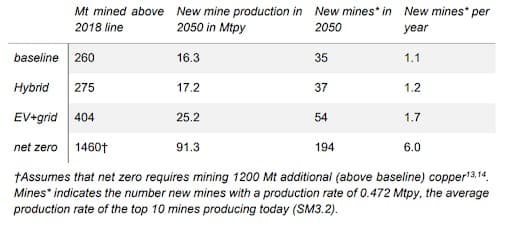- The rally in copper price has cooled off in recent weeks.
- Copper futures pulled back to below $9,000/t.
- IEF: the EV revolution alone will drive enough copper demand to outstrip supply in the next couple of decades.
The red-hot copper rally has cooled off in recent weeks, with prices pulling back from their May all-time high to close below $9,000/t. Just like in the oil markets, sentiment in copper markets has weakened, driven by weak U.S. manufacturing and labor market data, soft China data, and a sizable build in LME inventories.
Last week, Goldman Sachs downgraded its copper price forecast, due to weakening demand from China. GS now sees copper prices averaging $10,100 per metric ton in 2025, a sharp reduction from its previous forecast of $15,000. Further, Australian mining giant BHP Group (NYSE:BHP) recently downgraded its forecast for China’s copper demand amid concerns about the country’s economic recovery.
Thankfully for the bulls, the long-term copper outlook remains robust. A couple of months ago, Swiss multinational commodity trading company Trafigura predicted that EVs, Artificial Intelligence (AI), power infrastructure, and automation boom will drive at least 10 million metric tons of additional copper demand by 2035, According to Graeme Train, Trafigura’s head of metals analysis, one-third of the 10 million tons of new demand will come from the electric vehicle sector, "A third is electricity generation, transmission and distribution, and the rest is for things like automation, manufacturing capex and cooling systems within data centers," he said.
Saad Rahim, Trafigura’s chief economist, has projected that AI alone has the potential to add one million tonnes per annum of copper demand by 2030.
Jeff Currie, Chief Strategy Officer at The Carlyle Group (NASDAQ:CG) and former Global Head of Commodities Research at Goldman Sachs, has declared that copper is the new oil and the best trade he has seen in his career. The analyst has pointed out that copper has long been touted as a big winner from the world's drive towards electrification including electric vehicles and huge grid upgrades.
At the same time, Currie notes that it takes years for new copper mining capacity to actually come onstream. However, copper prices have, unexpectedly, pulled back sharply several times over the past two years. Currie says this has created a mismatch between short-term prices and long-term supply, making copper his highest-conviction trade ever.
Meanwhile, a recent study, published by the International Energy Forum (IEF) says the EV revolution alone will drive enough copper demand to outstrip supply in the next couple of decades. According to IEF, current projections show that copper production will increase 82% to hit a massive 37.1 million tonnes by 2050; however, supply will need to increase by an extra 55% to power an all-EV global fleet-- equating to the establishment of 194 new mines or six each year till 2050.
With an estimated 6.66bn tonnes of global copper resources identified, copper scarcity is not the main issue here, rather than the fact that it takes ~23 years to turn a copper discovery into a functioning mine. The lengthy development time suggests the world is facing a near-impossible task to develop enough mines to meet demand in the available timeframe.

Source: Mining.com
The report, however, notes that if copper recycling remains constant at its 2018 level rather than increasing as assumed, 43 new mines will need to come online every year, with the copper demand gap clocking in at 8.1 million tonnes in 2035 and 9.6 million tonnes in 2040.
It is worth noting that the study used the same methods to arrive at this dire picture as the one used by American geologist M. King Hubbert to accurately predict 30 years of U.S. oil production. However, Hubbert’s model broke when technologies such as hydraulic fracturing, directional drilling and Enhanced Oil Recovery (EOR) made it possible to produce natural gas and crude oil from shale and expanded the hydrocarbon resource. This offers the world a narrow window to expedite the process of bringing new copper mines online.
Hybrids A Potential Solution
IEF has also offered another way to ditch efforts to replace fossil fuel-powered vehicles with all-electric vehicles and instead replace them with hybrids.
“There is remarkably little difference between the amount of copper needed to manufacture hybrid electric rather than ICE vehicles,” with the researchers pointing out that hybrid electric vehicles require 29 kg of copper compared to 24 kg for an ICE (internal combustible engine) vehicle. “It would therefore be judicious to aim for a transition to the 100% manufacture of hybrid electric vehicles by 2035, rather than transitioning to the 100% manufacture of battery electric vehicles, which require 60 kg. The copper required for this transition is only slightly above baseline and does not require major grid improvements,” the report’s authors said.
Fossil fuel investors will no doubt be pleased to know that hybrids remain incredibly popular in this age where pure EVs have become dominant, a full 25 years since Toyota Motor Corp (NYSE:TM) launched the Prius. Nearly 3 million hybrid EVs were sold in 2022, good for nearly 30% of all EVs sold. Hybrids remain popular because they make considerable savings on gas and cut their carbon footprint without the attendant charging anxiety that comes with pure EVs.
In a hybrid car, there is an ICE component and an electric motor, with battery-stored energy. However, a hybrid can’t be plugged in to charge. Instead, it is charged by the regenerative braking of the internal combustion engine. The extra power provided by the electric motor can potentially allow for a smaller engine, adding some environmental benefits. The battery can also power auxiliary loads and reduce engine idling when stopped, according to the Alternative Fuels Data Center.
